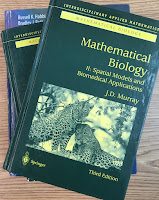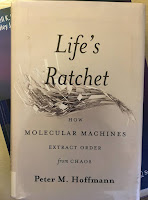 |
| The Spark of Life: Electricity in the Human Body, by Frances Ashcroft. |
In essence, this book is a detective story about a special kind of protein—the ion channel—that takes us from Ancient Greece to the forefront of scientific research today. It is very much a tale for today, as although the effects of static electricity and lightning on the body have been known for centuries, it is only in the last few decades that ion channels have been discovered, their functions unravelled and their beautiful, delicate, intricate structures seen by scientists for the first time. It is also a personal panegyric for my favourite proteins, which captured me as a young scientist and never let me go; they have been a consuming passion throughout my life. In Walt Whitman’s wonderful words, my aim is to “sing the body electric.”The book examines much of the history behind topics that Russ Hobbie and I discuss in the 4th edition of Intermediate Physics for Medicine and Biology, such as the work of Hodgkin and Huxley on the squid nerve axon, the electrocardiogram, and modern medical devices such as the pacemaker and cochlear implants. The book is definitely aimed at a general audience; having worked in the field of bioelectricity, I sometimes wish for more depth in the discussion. For instance, anyone wanting to know the history of pacemakers and defibrillators would probably prefer something like Machines in our Hearts, by Kirk Jeffrey. Nevertheless, it was useful to find the entire field of bioelectricity described in one relatively short and easily readable book. With its focus on ion channels, I consider this book as a popularization of Bertil Hille’s text Ion Channels of Excitable Membranes. Her book was also useful to me as a review of various drugs and neurotransmitters, which I don’t know nearly as much about as I should.
Here is a sample of Ashcroft’s writing, in which she tells about Rod MacKinnon’s determination of the structure of a potassium channel. Russ and I discuss MacKinnon’s work in Chapter 9 (Electricity and Magnetism at the Cellular Level) of IPMB.
A slight figure with an elfin face, MacKinnon is one of the most talented scientists I know. He was determined to solve the problem of how channels worked and he appreciated much earlier than others that the only way to do so was to look at the channel structure directly, atom by atom. This was not a project for the faint-hearted, for nobody had ever done it before, no one really knew how to do it and most people did not even believe it could be done in the near future. The technical challenges were almost insurmountable and at that time he was not even a crystallographer. But MacKinnon is not only a brilliant scientist; he is also fearless, highly focused and extraordinarily hard-working (he is famed for working around the clock, snatching just a few hours’ sleep between experiments). Undeterred by the difficulties, he simultaneously switched both his scientific field and his job, resigning his post at Harvard and moving to Rockefeller University because he felt the environment there was better. Some people in the field wondered if he was losing his mind. In retrospect, it was a wise decision. A mere two years later, MacKinnon received a standing ovation—an unprecedented event at a scientific meeting—when he revealed the first structure of a potassium channel. And ion channels went to Stockholm all over again.Ashcroft is particularly good at telling the human interest stories behind the discoveries described in the book. There were several interesting tales about neurotoxins; not only the well-known tetrodotoxin, but also others such as saxitoxin, aconite, batrachotoxin, and grayanotoxin. The myotonic goats, who because of an ion channel disease fall over stiff whenever startled, are amazing. Von Humboldt’s description of natives using horses to capture electric eels is incredible. The debate in Parliament about August Waller’s demonstration of the electrocardiogram, using his dog Jimmie as the subject, was funny. If, like me, you enjoy such stories, read The Spark of Life.
I will end with Ashcroft’s description of how Hodgkin and Huxley developed their mathematical model of the action potential in the squid giant axon, a topic covered in detail in Chapter 6 of IPMB.
Having measured the amplitude and time course of the sodium and potassium currents, Hodgkin and Huxley needed to show that they were sufficient to generate the nerve impulse. They decided to do so by theoretically calculating the expected time course of the action potential, surmising that if it were possible to mathematically simulate the nerve impulse it was a fair bet that only the currents they had recorded were involved. Huxley had to solve the complex mathematical equations involved using a hand-cranked calculator because the Cambridge University computer was “off the air” for six months. Strange as it now seems, the university had only one computer at that time (indeed it was the first electronic one Cambridge had). It took Huxley about three weeks to compute an action potential: times have moved on—it takes my current computer just a few seconds to run the same simulation. What is perhaps equally remarkable is that we often still use the equations Hodgkin and Huxley formulated to describe the nerve impulse.For more about The Spark of Life, see here, here, here, and here. Listen to and watch Ashcroft being interviewed by Denis Noble here, and giving the Croonian Lecture here.
Three years after finishing their experiments, in 1952, Hodgkin and Huxley published their studies in a landmark series of five papers that transformed forever our ideas about how nerves work. The long time between completing their experiments and publication seems extraordinary to present-day scientists, who would be terrified of being scooped by their rivals. Not so in the 1950s—Huxley told me, “It never even entered my head.” In 1963, Hodgkin and Huxley were awarded the Nobel Prize. Deservedly so, for they got such beautiful results and analysed them so precisely that they revolutionized the field and provided the foundations for modern neuroscience.
Francis Ashcroft being interviewed by Denis Noble.
Francis Ashcroft giving the Croonian Lecture.




